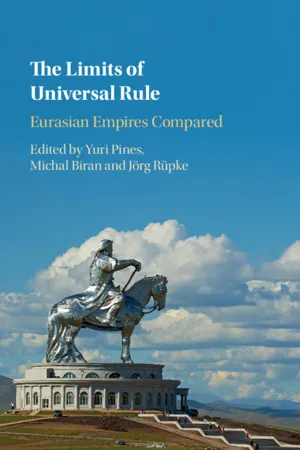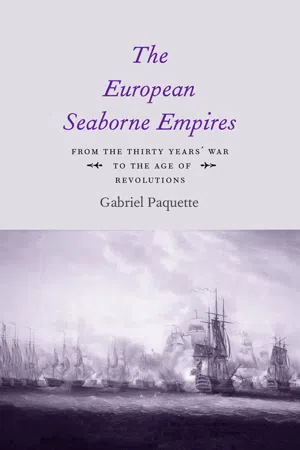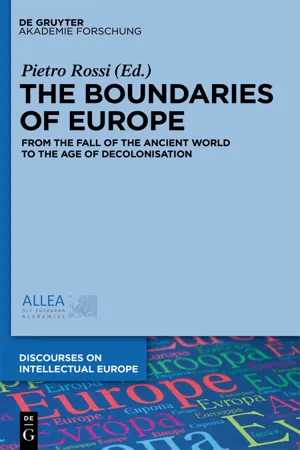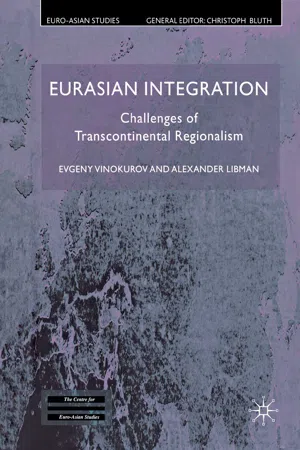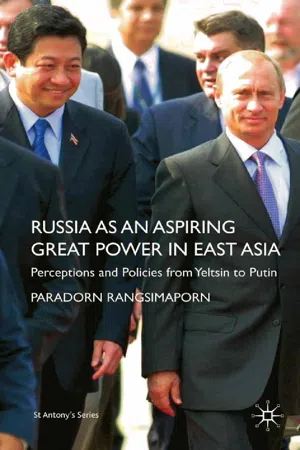History
Eurasian Empire
The Eurasian Empire refers to a historical entity that encompassed territories in both Europe and Asia. It is often associated with the vast and diverse empires that have held sway over these regions, such as the Mongol Empire and the Ottoman Empire. The concept highlights the interconnectedness of these two continents through political, cultural, and economic exchanges.
Written by Perlego with AI-assistance
Related key terms
1 of 5
10 Key excerpts on "Eurasian Empire"
- eBook - PDF
The Eurasian Project and Europe
Regional Discontinuities and Geopolitics
- David Lane, V. Samokhvalov, David Lane, V. Samokhvalov(Authors)
- 2016(Publication Date)
- Palgrave Macmillan(Publisher)
In fact, apart from the current member states of the Eurasian Economic Community, the Eurasian world histori- cally also incorporated Ukraine (to some extent), as well as Kazakhstan and Kyrgyzstan. Meanwhile, three other Central Asian republics – Turkmenistan, Tajikistan and Uzbekistan – were never considered a part of Eurasia as they can be distinguished by a slightly different mode of socioeconomic existence characterized by a thousand-year-long history of irrigation-based agriculture (and in fact they had been conquered and devastated rather than integrated into a Eurasian union by Genghis Khan during his raiding campaigns). 25 26 Eurasianism Past and Present My particular focus in this chapter is on Russia, which historically consti- tuted the core of the Eurasian world after the Mongol invasion. And it is in the history of this country, its particular societal and economic organization, as well as its relationships with other peoples of Eurasia, that we can capture the essence of Eurasia itself and its far-reaching influence over the internal and external affairs of the nations which populate it. The ecosystem of the vast Eurasian territory appears to have nourished the natural integrity of its people for centuries. In spite of an apparent ethnic, linguistic and anthropo- logical heterogeneity, it has formed a peculiar sociocultural reality marked by its specific values, societal and economic organization, structures of power and, eventually, geopolitical ambitions. Global civilization and local civilizations By the end of the 20th century it was quite tempting to approach devel- oping countries as fated to constantly catch up with the more advanced European civilizations. - eBook - PDF
The Limits of Universal Rule
Eurasian Empires Compared
- Yuri Pines, Michal Biran, Jörg Rüpke(Authors)
- 2021(Publication Date)
- Cambridge University Press(Publisher)
Without at least a pretension to maintain superiority over its neighbors, an empire loses its most essential imperial feature. This understanding explains why we have opted to leave European colonial powers out of this volume. (The only exception is Russia, which, as Burbank [Chapter 10] demonstrates in this volume, was primarily indebted to the Mongolian, or in Burbank’ s definition, “Eurasian” mode of empire-building.) Europe did not lack individual emperors who tried to dominate the entire continent (and not just their overseas colonies): Charles V (1500–58) (Tracy 2002) and most notably Napoleon (Woolf 1991) come immediately to mind. Yet they were exceptions, not the rule. For most of the time, European colonial empires could satisfy themselves with a status of equality with other major continental powers, or, at most, strive for the primus inter pares type of 8 For the most extreme example of inclusive approach, see the recently published Encyclopedia of Empire with over 400 entries (MacKenzie 2016). 7 Introduction: Empires and Their Space dominance (as was observable in the case of Great Britain). This normative acceptance of equality with neighboring states distinguishes European colonial empires from their Eurasian predecessors. Hence, for the time being, we prefer not to discuss these case studies and focus on the empires with less equivocal universalistic claims. 3 Eurasian Empires: Spatial and Temporal Distinctions Our exploration of “world empires” is limited to the Eurasian continent (including North African regions that were ruled from time to time by Eurasian Empires). This spatial focus is not fortuitous. Eurasia comprises no less than five macro-regions – namely, Europe, the Near East, the Indian subcontinent, the steppe belt of Inner Asia, and continental East Asia – that are useful for the comparative study of empires. - eBook - PDF
European Regions and Boundaries
A Conceptual History
- Diana Mishkova, Balázs Trencsényi, Diana Mishkova, Balázs Trencsényi(Authors)
- 2017(Publication Date)
- Berghahn Books(Publisher)
Finally, in what is perhaps Eurasia’s most genuinely radical resignification, the term is now used analytically in literal reference to the entire continent of Asia plus Europe. Practitioners of “world” or “global” or “big” history have promoted the need to view greater Eurasia in this way as a single physical en-tity. In particular, this geospatial shift of focus has an instrumental function within the epistemology of the world history project, by helping to transcend the limitations of national or imperial boundaries and recognize longue durée patterns of social and commercial interaction across global spaces (Kalivas and Martin 2008). In some cases, this perspective treats Eurasia essentially as a network or system of linkages (Dale 1994; Bentley 1998; Abu-Lughod 1998; Lieberman 1999; Gann 2003), while elsewhere greater Eurasia is con-sidered as a cohesive historical-geographical entity—a “Eurasian ecumenical whole,” as William McNeill (1964; 1987; 1995) puts it—characterized by an enduring historical distinctiveness and a special role in global history. The importance of environmental conditions continues to be emphasized, but rather than bifurcating the continent as before these are now seen as unifying factors (Diamond 1997; Landes 1998). This notion of greater Eurasian unity is then projected onto the present and future in a body of literature dealing with the twenty-first-century economic integration of the “Eurasian ‘super-continent,’” stretching from the Atlantic to the Pacific and from the Arctic to the Indian Ocean (Stokhof et al. 2004; Linn and Tiomkin 2005; Linn and Tiomkin 2006; Cho 2007; Roessler 2009; Vinokurov and Libman 2012). 224 Mark Bassin Mark Bassin is the Baltic Sea Professor of the History of Ideas, in the Center for Baltic and East European Studies at Södertörn University, Stockholm. His research focuses on problems of space, ideology, and identity in Russia and Germany. - eBook - PDF
The European Seaborne Empires
From the Thirty Years' War to the Age of Revolutions
- Gabriel Paquette(Author)
- 2019(Publication Date)
- Yale University Press(Publisher)
The challenge is largely attribut-able to the variety, range, and complexity of entities that have been designated 18 d e f i n i t i on s o f “ e m pi r e ” “empires” by historians. There have been numerous efforts to arrive at a single definition. Here I mention in passing several of the more successful attempts. These tend to treat empire as emerging from overlapping processes involving the imposition of authority by one group upon another, focusing on the asym-metrical relationship established between them. Historian John Darwin argued that empire is “the assertion of mastery (by influence or rule) by one ethnic group, or its rulers, over a number of others.” Political scientist William Doyle defined empire as “a relationship, formal or informal, in which one state controls the effective political sovereignty of another political society.” Polit-ical scientist David Abernethy distilled empire into the “relationships of domi-nation and subordination between one polity (called the metropole) and one or more territories (called colonies) that lie outside of the metropole ’s boundaries yet are claimed as its lawful possessions.” Mastery, control, domination, and subordination are the prominent, common features of these definitions, with good reason. Historian Stephen Howe encompassed these features in a single definition: “An empire is a large, composite, multi-ethnic or multinational political unit, usually created by conquest, and divided between a dominant center and subordinate, sometimes far distant, peripheries.” 3 I find Howe ’s formulation to be a suitable working definition, provided that it is fleshed out and several caveats are made. First, one must remain cognizant of the violence and unremitting coercion to which subject popula-tions were exposed following the entrenchment of European authority. - eBook - PDF
- Hui Wang, Wang Hui, Michael Gibbs Hill(Authors)
- 2014(Publication Date)
- Harvard University Press(Publisher)
Third, they possess multiple structures of power, with concentrated central power and structures of power generated by local culture existing side by side. Fourth, they work to make their own culture universal or to serve as the representative of “civilization”; this type of universal culture or civili-zation, however, is characterized by its hybridity and is not monolithic. Following a groundswell of nationalism in the nineteenth century, the deep suspicion of this type of empire, with its multiple centers of power, multinational ethnic makeup, and limitlessness, came to serve as one historical justification for the legitimacy of the nation-state model. An unavoidable question remains, however: Since modern China was estab-lished on the historical foundations laid by the Qing dynasty, how are we to understand the continuities between “empire” (diguo) and “nation” (minzu) ? After his systematic inquiry into the meanings of the term “empire,” Dominic Lieven concluded: Over the last two millennia the word “empire” has meant many dif-ferent things to different people from different countries at differ-ent times. Indeed it has often had different meanings to people from the same country at the same time. Statesmen and political thinkers have on occasion noted the word’s ambiguity, themselves deliberately using it in different contexts to convey a variety of meanings. 9 This specialist in the history of the Russian Empire and in the compara-tive history of empires gives us a sketch of the rich and ambiguous history of the concept of empire and, against a global backdrop, describes the rise and fall of various major empires. The concept of empire was still linked with such concepts as prosperity and strength at the beginning of the twentieth century; its devaluation took place only during a distinct period in which Nazi Germany appropriated the concept of empire and when, during the Cold War, Western nations regularly used the term to castigate the Soviet Union. - eBook - PDF
- Gerard Delanty, Engin F Isin, Gerard Delanty, Engin F Isin(Authors)
- 2003(Publication Date)
- SAGE Publications Ltd(Publisher)
In this context, the main divid-ing line was drawn between the ascendant Western European region (together with its transatlantic extension) and the major Near Eastern and Asian civilizational complexes. A meta-historical contrast was, in other words, used to set a triumphant periphery apart from the rest of the Eurasian continent. Since North African developments and connections were subsumed under the notion of the East (and the rest of the African continent largely disre-garded), the question of a broader Afro-Eurasian region did not arise. Another source of ambiguity was, however, more important for later elaborations of the distinction between East and West. Alongside the Western European turn to overseas empire-building, the Russian empire emerged as another major spearhead of expansion and a contender for power within the European state system. From the viewpoint of more self-assuredly Western observers, this new arrival from Europe’s periphery was an unset-tled mixture of Eastern and Western elements; variations on that theme, ranging from the pro-jects of Westernizing reformers or revolutionar-ies to the counter-arguments of ‘Eurasianists’ who stressed Eastern sources and prospects, became an enduring concern of Russian self-interpretations. The ambiguous identity of Russia lent support to similar views of its Byzantine background, more easily ‘easternized’ in retrospect than at a time when Byzantium coexisted and interacted with Western Christendom. More conspicuously, the image of Russia as at least partly Eastern could be trans-ferred – with much more overtly strategic aims – to the Soviet incarnation of the empire: the ultimate version of the dichotomy discussed above was an ideological model of the bipolar world that took shape after the Second World War. - eBook - ePub
The Boundaries of Europe
From the Fall of the Ancient World to the Age of Decolonisation
- Pietro Rossi(Author)
- 2015(Publication Date)
- De Gruyter(Publisher)
Alberto Masoero Russia between Europe and Asia 1 An Empire with Uncertain Boundaries The transcontinental location of the Russian state is a constant factor throughout its history. It fostered a multiplicity of religious, cultural and institutional relations, largely spontaneous and pluridirectional, and not necessarily implying a clear dichotomy between East and West. After all, Europe and Asia meant different things in different centuries. Like a sponge, Russia absorbed its military vocabulary from German and the word chay for tea – the second most popular national drink – from Mandarin Chinese. This intermediate position affected the evolution of its borders, but also influenced representations of national identity and the ideology of the state. In the sixteenth century the Tsardom of Russia began its eastward expansion by conquering the Tatar states of Kazan and Astrakhan, and to some extent it inherited the legacy of Mongol rule. It consolidated its power in the West, resisting the interference of the Polish-Lithuanian Commonwealth, a more prestigious and powerful state at the time. The Tsar would also, after the partitions of Poland in the eighteenth century, claim the title of King of Poland. The centuries-old process of territorial expansion, directed towards different regions of Europe and Asia at different times, encountered its main setbacks during periods of profound political, social and economic crisis, accompanied by significant losses of territory and by discontinuities in dynasties and in the form of the state - eBook - PDF
Eurasian Integration
Challenges of Transcontinental Regionalism
- E. Vinokurov, A. Libman(Authors)
- 2012(Publication Date)
- Palgrave Macmillan(Publisher)
The existence of great empires, however, was not the only contribu- tor to the rise of the Eurasian exchange. The Tang-Caliphate period did The Waves of Eurasian Exchange 37 not, in fact, generate a new wave of exchange (although the Central Asian ambitions of the Tang Dynasty did contribute greatly to cultural exchanges). The early modern period provides even better examples of this: the Ottoman Empire, the Russian Empire and the Qing Dynasty, although they were established and vast continental empires, failed to create the impetus for economic exchange. In fact, the empires seem to have restricted the opportunities for exchange which had existed before and instead helped to redirect trade flows beyond Central Eurasia. Thus, Eurasian exchange proliferated only because a fragile balance was maintained between the positive and negative influences on trade the empires exerted. Furthermore, the influence of an empire is not necessarily the same as its territorial domination. The most obvious example of this effect is the 'Byzantine commonwealth of nations'24 or the expansion of Indian cultural influences during the Kushan Gupta period. The two elements of Eurasian exchange - its maritime and overland connections - meant that Central Asia and the Indian Ocean were cru- cial for the evolution of economic linkages. The Indian Ocean was an area of intensive economic and cultural exchange long before European expansion. The importance of this ocean for trade was similar to that of the Mediterranean Sea in the Western part of Eurasia; however, unlike the Mediterranean region under the Romans, the Indian Ocean never became a domain of one single political power (the Chinese expedi- tions of Zheng He could probably have achieved this domination, but the Chinese government put a stop to them). - eBook - PDF
Russia as an Aspiring Great Power in East Asia
Perceptions and Policies from Yeltsin to Putin
- P. Rangsimaporn(Author)
- 2009(Publication Date)
- Palgrave Macmillan(Publisher)
42 42 4 The Many Faces of Eurasianism Russia has always considered itself to be a Eurasian (Evroaziatskaia) country. We have never forgotten that a greater part of Russian territory lies in Asia. But frankly speaking, we have not always used that advantage. I think the time has come for us and the Asia-Pacific countries to go over from words to deeds . . . to build up economic, political and other contacts. Russia has all the requisite possibilities for this now. (Vladimir Putin) 1 Putin’s statement above reflects the recognition that Russia’s unique Eurasian position could help enhance Russia’s engagement with East Asia. But there were many different elite interpretations of Eurasianism and their associated policy implications with regards to East Asia, which this chapter examines. How the elite perceived their Eurasian identity sheds much light on how they perceived East Asia and their role in that region. As seen in Chapter 3, Russia’s Eurasian identity was used to justify the pursuance of a balanced and multi-vectored foreign policy that rejected the early Western orientation. Eurasianism lent Russia the self-perceived right to be involved in its neighbouring regions’ affairs, including East Asia’s. Eurasianism thus helped justify Russia’s claim to great power- ness and legitimate role in East Asian affairs. This great-power percep- tion underlines the three major elite interpretations of Eurasianism with regards to East Asia discussed here. Although each interpretation may have different policy implications, they share the instrumentalist inter- pretation of Eurasianism to varying degrees. Rather than seeing it as a genuine alternative for Russia’s national identity in sociocultural terms or more tellingly as the portrayal of any cultural or social affinity with Asia as earlier Asianists had done, 2 Eurasianism is perceived as a rationale for Russia to have a greater role and influence in East Asia as befits its great power and unique Eurasian identity. - eBook - PDF
- Alexei Miller, Alfred J. Rieber, Alexei Miller, Alfred J. Rieber(Authors)
- 2004(Publication Date)
- Central European University Press(Publisher)
During the confusion of the Chinese revolution of 1911 the Russians supported the Mongols’ dec-laration of independence.Yet even with Russian and later Soviet support they had to wait more than three decades before China fully relinquished its claims and recognized, in 1945, Outer Mongolia’s full independence. 82 197 IMPERIAL RULE C ONCLUSION To return to the aims of this essay, the concept of complex frontiers offers an alternative to the theory of the clash of civilizations and theories of un-limited expansion. Empires not civilizations are the agents of cultural and political interaction. Imperial competition and conflict on the one hand and the migration, deportation and colonization of people on the other hand contributed to creating broad bands of territory on the frontiers of the Eurasian Empires inhabited by highly variegated ethnic and religious groups. Their interaction with one another and their reaction to imperial conquest oscillated between cultural and commercial exchange and various forms of violence ranging from raids to low level warfare and rebellion. Imperial atti-tudes and policies toward these populations were also ambiguous or con-tradictory. They alternated between toleration and political concessions to forced assimilation and repression. Empires differ most strikingly from nation states in their way of imag-ining and fixing their boundaries. The contrast stems from diverse concep-tions of universalism and power. Imperial ideologies are inspired by the ideal of universal domination but accept limitations imposed by their own cultural traditions and the constraints of power politics. The first of these limiting factors arises from a self-generated definition of what constitutes a universe. In the case of the Eurasian Empires the basis was religious or eth-ical often if not always related to a foundation myth. A messianic element is almost always present in one of two forms; it is either inner or outer di-rected.
Index pages curate the most relevant extracts from our library of academic textbooks. They’ve been created using an in-house natural language model (NLM), each adding context and meaning to key research topics.

